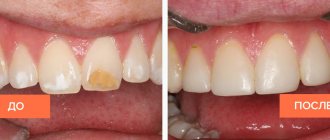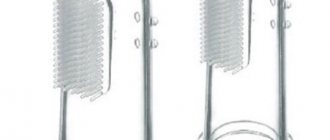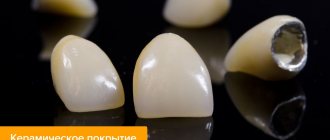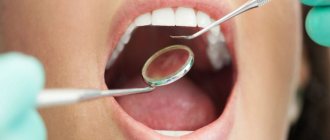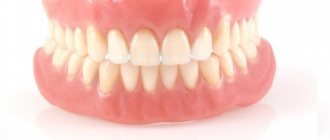Metal-ceramic crowns are the most popular method of dental prosthetics because they have a number of advantages: their appearance is as close as possible to natural, and they can last for many years without signs of wear.
Metal-ceramic prostheses are made in the form of bridges or crowns. Crowns made of this material perfectly replace molars, for which functionality is primarily important.
And although such prostheses are highly durable, they require certain care. Following some simple rules allows you to keep crowns in excellent condition and significantly increases their service life.
What types of dentures are there and what are they made of?
Today, the types of dentures, as well as the materials from which they are made, are varied. If the patient is missing one tooth and its root has not been preserved, then it would be best to install an implant and a dental crown on it. If several teeth are missing in the oral cavity, the situation will be saved by installing a bridge (possibly also on implants as the most reliable design). In the case of complete edentia, we will talk about restoring teeth using a complete denture, be it a fixed denture on implants or a complete removable denture.
We should not forget that the material from which dental crowns are made is no less diverse than the structures on which these crowns are fixed. In this case, the beauty and strength of the crown part of the tooth will depend on the material .
Considering the high degree of desired aesthetics, we can safely say that metal dental crowns are hopelessly outdated, just like crowns made of precious metals (white beautiful teeth have long replaced shiny gold teeth). The leading positions are occupied by zirconium dioxide crowns and all-ceramic dental crowns (metal-free ceramic crowns). But along with them, thanks to decent aesthetics and reasonable prices, metal-ceramic crowns remain quite in demand, which we will talk about in more detail.
The need to install a crown on a metal-ceramic tooth
It is advisable to install a metal-ceramic crown to restore a tooth that cannot be restored with filling, for installation on an implant, and also when tooth enamel is highly abrasive. Such prostheses can serve as a replacement for previous metal or plastic ones.
Metal-ceramics restores the natural shape of teeth with high precision and is almost the same in shape and texture. After prosthetics, the patient does not feel discomfort, there are no defects in speech and chewing function. It is practiced to install metal-ceramic dentures on teeth and crowns in the complete absence of dentition. The introduction of crowns is advisable regardless of the type of tooth.
Due to the hygiene and material, the crown is resistant to the influence of pathological microflora, bacteria, and fungi.
In case of abnormalities in the development of the dentition, if inlays or veneers are contraindicated, a crown will be the best option.
During operation, the prosthesis does not change color and is not affected by natural pigments, food coloring, nicotine, caffeine, etc.
Contraindications include:
- allergic reactions to product materials;
- periodontal disease and severe periodontitis;
- malocclusion;
- bruxism;
- low set teeth;
- excessive tooth mobility.
To avoid unwanted reactions and consequences after installing a prosthesis, you must carefully read the contraindications.
Making a crown on a tooth, before and after photos
Metal-ceramic dentures
Metal-ceramic dentures are dental crowns consisting of a metal frame and a ceramic coating. This design looks quite natural and lasts a long time, so metal-ceramic crowns are installed both in place of one missing tooth and several teeth in the dentition (in this case we are talking about a bridge made of metal-ceramics). The metal-ceramic frame of the future crown is made from alloys of nickel and chromium, cobalt and chromium, a base of palladium and silver, gold or platinum. The latter components rarely fit into the pricing policy for metal-ceramic crowns, which stably maintains the demand for this type of dental crown, so the decision to install a metal-ceramic crown is still supported taking into account inexpensive manufacturing materials, which ensure the low cost of metal-ceramic dentures.
The procedure for installing a crown on a metal-ceramic tooth
After the preparatory procedures, the tooth must be sharpened to the size of the crown. An orthopedic dentist takes an impression to form a model of the prosthesis. The actual production of the crown is performed by a dental technician in a dental laboratory.
Typically, a crown on a tooth takes time to produce. Before receiving a permanent prosthesis, the client must visit a specialist at least three times. The duration of the entire process is from seven to ten days, not taking into account the treatment time.
While the permanent crowns are being made, the client will have a temporary plastic crown installed. This is necessary to protect the implant or ground tooth from the influence of food and saliva.
After trying on the finished product, if the patient is comfortable with the prosthesis, it is attached to the implant using a special solution.
Making a crown for a tooth from metal-ceramics
When can metal ceramics be installed?
Metal-ceramic dental crowns will be an excellent alternative to other dentures in the case of the absence of one tooth in any part of the dentition, although, given the availability today of more aesthetic dentures, metal-ceramics are preferred to be installed in the chewing area of the upper or lower jaws. Dental crowns made of metal-ceramics are often used to restore several lost teeth in a row - this design is called a “metal-ceramic bridge.” Typically, a metal-ceramic bridge replaces up to four missing teeth.
Features of metal-ceramic tooth crowns
Such products can serve uninterruptedly for more than ten years; with the correct load during chewing, high-quality installation, and proper care, the period increases.
The manufacture of prostheses requires professional knowledge, materials whose quality is confirmed by a certificate, and laboratory conditions. By observing all the required standards, prosthetics will be completely safe for the client.
Despite the fact that metal-ceramic crowns do not emit toxic substances during use, they can behave in different ways in the mouth, each case is individual. A frame made of nickel or chromium-nickel alloy can cause allergies if the structure is based on a base metal; it will oxidize over time when in contact with saliva.
The high strength of the crowns allows for greater loads when chewing. Due to their aesthetic appearance, the products are often installed to cover the front teeth, as well as premolars and molars.
The metal-ceramic crown is highly durable, does not wear off and is not subject to carious changes.
There are cases of puncture, to eliminate the problem there is no need to remove the product; specialists correct the prosthesis in the oral cavity.
One of the disadvantages is the high degree of grinding of the abutment tooth. Most often, the tooth is depulped and the root canals are filled. In this case, it is necessary to remove the nerve to avoid burns to the pulp.
Making a crown for a tooth from metal-ceramics
How to care for metal-ceramic dentures?
There is no need to talk about the fact that the basis of oral hygiene is brushing your teeth twice a day. The presence of metal-ceramic dentures in the oral cavity makes this rule unshakable. In addition, it is necessary to clean metal-ceramic dentures in a strictly specified direction - upward from the base to the top of the tooth, removing plaque and accumulated food particles from the spaces not only between the teeth, but also between the teeth and gums. More thorough care, of course, is facilitated by the use of an irrigator, which helps literally wash away food debris. It is also recommended to rinse the mouth with special disinfecting and anti-inflammatory solutions, use dental floss and other tools for cleaning dentures. If we are talking about caring for removable metal-ceramic dentures, in this case it is mandatory to rinse the denture under running water to avoid the accumulation of remaining food particles after eating and, as a result, bad breath. Thus, basic rules of oral care at home can significantly extend the service life of unpretentious metal-ceramic dentures. If you need more serious help, you can always contact a dental hygienist, who will definitely adjust the action plan.
What does dental care consist of?
Let's look at how to care for metal-ceramic dentures:
- Clean the mouth at least twice a day.
- Disposing of leftover food after every meal, including snacks.
- It is advisable to avoid the use of nicotine, tea and coffee, which can leave unpleasant stains on dentures.
- Regular visits to the doctor to remove the plaque that has formed.
- Regularly remove structures at night, placing them in a special solution, or leaving them dry.
- Avoiding exposure to too high and low temperatures, as well as their changes.
- Do not try to chew hard foods, open bottles with your teeth, etc., which causes a lot of stress and can damage the prosthesis.
Caring for ceramic crowns and veneers
The long-awaited moment that you have been waiting for has happened - you have had all-ceramic crowns and veneers installed on your teeth, or something else, and now, when the first delight of your renewed smile has receded, a logical question arises in your head: how to properly brush your teeth with veneers and crowns, How to organize such care so that the structures last as long as possible? We will answer this question in this article. Let's look at the basic concepts, and so what are a crown and a veneer and what is their fundamental difference? A veneer is a very thin microprosthesis, the main function of which is to restore aesthetics lost for some reason. Veneers can and should be installed in two cases - minor defects in the surface of the teeth in the smile area, when there is no need for large-scale restoration with serious orthopedic structures. Thus, restoration with ceramic veneers is most often performed on the front teeth. Ceramic veneers are practically not placed on chewing teeth, which is due to the large load on them, which such a small structure cannot withstand. Indications for installation of veneers:
- The presence of three and diastemas between the teeth (gaps) - can occur with age or be genetically determined in the case of, for example, small teeth, large jaw sizes, or a violation of the position of some teeth.
- Various violations of the integrity of the enamel (chips or cracks) without compromising the integrity of the crown.
- Discoloration of teeth (stains, yellowness, stains, non-carious lesions, discoloration under the influence of chemicals that cannot be corrected therapeutically).
- Increased sensitivity of teeth, which cannot be corrected conservatively
Ceramic dental veneers are made as follows:
1. Examination by a doctor, diagnostic measures, drawing up a treatment plan, preparing (turning) the tooth for a veneer, making a temporary structure. 2. There are 3 methods for creating veneers:
- Layer-by-layer application of ceramics directly onto a previously prepared tooth on a model made of refractory plaster with firing at high temperatures of each layer.
- Modeling the structure on a model with subsequent replacement of wax with ceramics.
- Modeling and manufacturing using CAD/CAM technology. A virtual scan of the patient’s oral cavity takes place, this information is transferred to the computer, the future veneer is modeled, the computer, in turn, transfers the file to a special milling machine where the future prosthesis is “turned” from a block of ceramic.
- Fixation of veneer in the oral cavity
A crown is a full-fledged structure designed to restore the full integrity of the tooth and its function. Ceramic crowns for chewing teeth today are the optimal restoration option both aesthetically and functionally.
We remember that crowns can have a metal frame - made of cobalt-chromium alloy, zirconium oxide, lithium dioxide, which is later coated with ceramics. A ceramic crown with zirconium dioxide as a frame is maximally biocompatible and meets all the requirements of modern dentistry. Ceramic crowns for the front teeth are most often made without a metal frame - directly from ceramics. Let's look at the main advantages of a metal-free ceramic crown over a metal one.
- Less depth of tooth turning for structures due to the possibility of creating a highly accurate and aesthetic structure, even without a metal frame.
- The most precise fit to the tooth tissues, the absence of a “blue strip” at the gums - which ensures high aesthetics and the impossibility of distinguishing the crown from natural teeth with the naked eye.
- No reactions to metal in the oral cavity, because it is known that the fewer foreign components in the mouth, the better.
Caring for ceramic crowns and veneers:
- Brushing your teeth 2 times a day with a brush, paste and dental floss selected by your dentist. The paste for cleaning crowns and veneers is the same as for natural teeth.
- How to whiten veneers? It is necessary to alternate preventive toothpaste with whitening paste, which is more abrasive and if there is a need to lighten the teeth by several tones.
- Our patients often ask the question: what can and cannot be eaten after veneers are installed? The diet does not need correction; you can eat everything, avoiding hard food getting on the structures to prevent damage. Aesthetic crowns, like natural teeth, tend to be stained by food dyes. This plaque can be easily removed by a doctor, but to preserve the original appearance for a longer period of time, you should not get carried away with coloring drinks and products. In addition, try to avoid sudden temperature changes so that cracks do not form on the surface of the prosthesis, which can negatively affect the appearance and design features.
- Professional cleaning of ceramic crowns and veneers is carried out along with other teeth 1-2 times a year using an ultrasonic scaler, air-flow apparatus and subsequent polishing of all teeth with special brushes.
- We strongly recommend that all patients with orthopedic structures in the oral cavity use an irrigator at home. This device allows for very high-quality care due to a large set of special attachments and ease of use.
We are looking forward to seeing you in our clinic, where specialists will produce the perfect prosthesis with the highest quality and speed, which will give you joy for many years!
Recommendations after metal-ceramic prosthetics are completed
And now the metal-ceramic prosthetics is completed. You can and should smile, smile, and chew, chew, chew. But many questions arise: can I eat, drink and rinse my mouth right away? What can you eat with metal ceramics and what can’t you eat? How to care for it, what to clean it with? Will plaque form on it? Is it getting dark or not? Is it washable or not? How long will metal-ceramic prosthetics please its owner and what will have to be done in the distant future?
Let's clarify all these questions. Is it possible to rinse and drink immediately after metal-ceramic prosthetics are completed? It depends on the cement that the doctor uses. We use a composition that is not afraid of moisture and saliva either during cementation or after. It sets quickly and prevents tooth decay. That's why we allow you to eat, drink and rinse right away. But keep in mind, this depends on the cement that is used!
You can also eat immediately. But we recommend that after metal-ceramic prosthetics you don’t eat hard food for a couple of days - it’s still not quite familiar and you can accidentally bite your lip, cheek or tongue (depending on your appetite).
The first few days after any prosthetics, including metal-ceramic ones, you need to get used to it and adapt. Why do you need to get used to crowns? How so? Were they made individually? Maybe this is not individual work at all, but a standard execution without taking into account individual characteristics, so you need to get used to them? Not at all. The fact is that even when filling a tooth, you have to get used to the filling in a new way. But this is done quite quickly: caries is removed and covered with layers of filling. Everything about everything: an hour to an hour and a half. But even with this, you have to get used to the new volumes. Although it completely repeats the previous contour of the tooth.
Metal-ceramic prosthetics takes an order of magnitude longer - at least a week. And the volume of changes far exceeds tooth filling. Even with temporary crowns, you need to adapt to permanent ones. Not to mention metal-ceramic prosthetics without them - first the teeth are processed and the patient is forced to get used to the processed teeth, which take up less space than before treatment and after installing crowns. Getting used to it usually takes several days. If metal-ceramic prosthetics is large in volume and number of teeth involved, then it will take a week or two.
The first few days the diction may even be changed. This happens when metal-ceramic prosthetics involves several front teeth. Which decisively influence, and indeed create, diction and phonetics. To speed up adaptation, more training is recommended: talking more, chatting on the phone, arguing with a neighbor, etc. The more training, the faster pronunciation is restored.
Read about how to preserve metal-ceramic prosthetics for many years here.
Read more >>>

